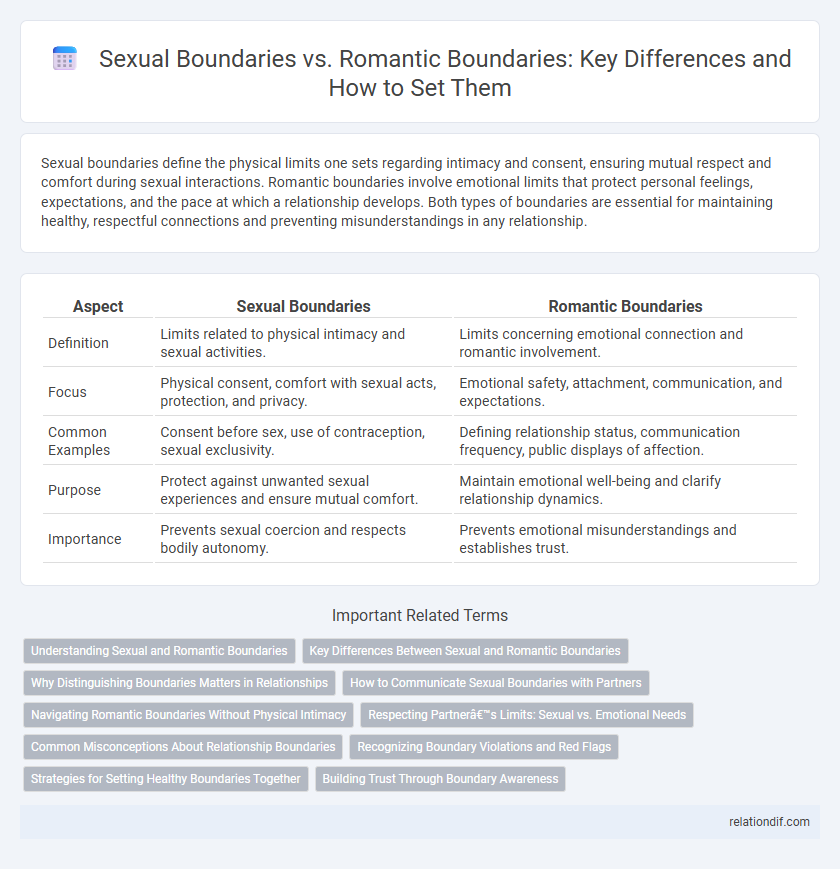Sexual boundaries define the physical limits one sets regarding intimacy and consent, ensuring mutual respect and comfort during sexual interactions. Romantic boundaries involve emotional limits that protect personal feelings, expectations, and the pace at which a relationship develops. Both types of boundaries are essential for maintaining healthy, respectful connections and preventing misunderstandings in any relationship.
Table of Comparison
| Aspect | Sexual Boundaries | Romantic Boundaries |
|---|---|---|
| Definition | Limits related to physical intimacy and sexual activities. | Limits concerning emotional connection and romantic involvement. |
| Focus | Physical consent, comfort with sexual acts, protection, and privacy. | Emotional safety, attachment, communication, and expectations. |
| Common Examples | Consent before sex, use of contraception, sexual exclusivity. | Defining relationship status, communication frequency, public displays of affection. |
| Purpose | Protect against unwanted sexual experiences and ensure mutual comfort. | Maintain emotional well-being and clarify relationship dynamics. |
| Importance | Prevents sexual coercion and respects bodily autonomy. | Prevents emotional misunderstandings and establishes trust. |
Understanding Sexual and Romantic Boundaries
Understanding sexual boundaries involves recognizing personal limits related to physical intimacy, consent, and comfort levels, ensuring respect for one's own and others' bodies. Romantic boundaries focus more on emotional aspects, such as expectations of communication, affection, and commitment, which help maintain a healthy balance in relationships. Clear communication about both sexual and romantic boundaries prevents misunderstandings and fosters trust between partners.
Key Differences Between Sexual and Romantic Boundaries
Sexual boundaries primarily involve physical limits related to intimacy and consent, such as what types of touch are acceptable and when sexual activity is appropriate. Romantic boundaries focus on emotional aspects, including expressing feelings, commitment levels, and personal space within affectionate interactions. Understanding these key differences helps individuals communicate their comfort zones clearly, ensuring both physical safety and emotional well-being in relationships.
Why Distinguishing Boundaries Matters in Relationships
Distinguishing sexual boundaries from romantic boundaries is essential for fostering trust and clarity in relationships. Sexual boundaries pertain to physical limits and consent, while romantic boundaries involve emotional needs and expectations. Recognizing this difference helps partners communicate effectively, respect each other's comfort zones, and build a healthier, more balanced connection.
How to Communicate Sexual Boundaries with Partners
Communicating sexual boundaries with partners requires clear, honest conversations that prioritize mutual consent and respect. Using specific language to express comfort levels, preferences, and limits helps prevent misunderstandings and fosters trust. Regularly revisiting these discussions ensures both partners remain aligned as feelings and boundaries may evolve over time.
Navigating Romantic Boundaries Without Physical Intimacy
Navigating romantic boundaries without physical intimacy requires clear communication and mutual respect to establish emotional connection while honoring personal limits. Prioritizing consent, setting expectations, and recognizing non-physical expressions of affection foster trust and deeper understanding. Maintaining these boundaries enhances relationship stability and supports individual comfort within romantic dynamics.
Respecting Partner’s Limits: Sexual vs. Emotional Needs
Respecting a partner's sexual boundaries involves clear communication about physical consent and comfort levels, ensuring that intimacy aligns with both individuals' desires and limits. Romantic boundaries, by contrast, emphasize acknowledging emotional needs, such as the pace of relationship progression and expressions of affection. Balancing these boundaries fosters trust and emotional safety, promoting a healthy partnership where both sexual and emotional limits are honored.
Common Misconceptions About Relationship Boundaries
Sexual boundaries define the limits related to physical intimacy, while romantic boundaries encompass emotional closeness and personal space. A common misconception is that romantic boundaries are less important than sexual ones, leading to misunderstandings in communication and consent. Clear distinction and respect for both types of boundaries are essential for healthy, balanced relationships.
Recognizing Boundary Violations and Red Flags
Recognizing boundary violations involves identifying unwanted physical advances, pressure for sexual activity, or disrespect of personal space, which are key indicators of breached sexual boundaries. Romantic boundary violations often include manipulation, excessive jealousy, or ignoring consent regarding emotional availability and communication limits. Red flags such as coercion, disregard for "no," and persistent intrusion signal the need for assertive boundary reinforcement to maintain healthy relationships.
Strategies for Setting Healthy Boundaries Together
Establish clear communication channels where both partners express their comfort levels regarding sexual and romantic boundaries, ensuring mutual understanding. Create mutually agreed-upon rules that respect individual needs and prioritize consent to foster trust and emotional safety. Regularly revisit and adjust boundaries together to accommodate evolving feelings and maintain a healthy, balanced relationship dynamic.
Building Trust Through Boundary Awareness
Sexual boundaries define physical limits and consent, while romantic boundaries involve emotional expectations and communication. Recognizing and respecting both types of boundaries fosters trust and deepens intimacy by ensuring partners feel safe and valued. Clear boundary awareness reduces misunderstandings and enhances mutual respect in relationships.
Sexual boundaries vs romantic boundaries Infographic

 relationdif.com
relationdif.com